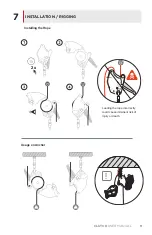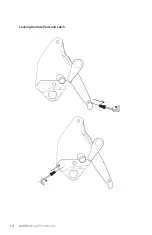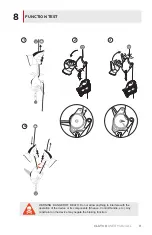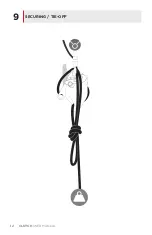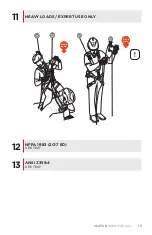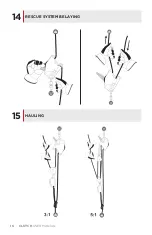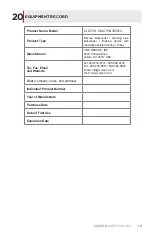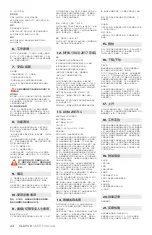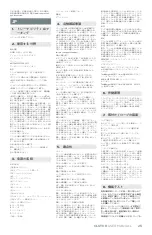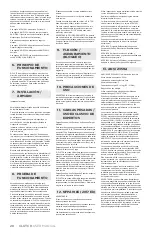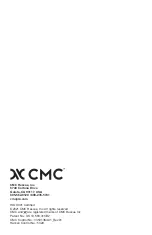
CLUTCH
USER MANUAL
23
16. DESCENT AND
LOWERING
Descent/Lowering
Avoid slack in the line between the user and the anchor
point. Firmly grip the braking side of the rope and gradually
pull on the control handle to adjust the descent speed.
For loads between 30 kg and 200 kg, limit the speed to
below 2 m/s. For loads over 200 kg, limit the speed to
below 0.5 m/s. Speed can be judged by monitoring the
fleckingpatternontheropepassingthroughthedeviceor
by calculating target descent times for known distances.
For heavy load and long descents, it is advisable to limit
the speed to a lower value to minimize heat build up in the
device. To stop the descent let go of the control handle.
If the Control Handle is pulled too far in a panic situation,
thedevicelockstherope.Tocontinuethedescent,first
reset the Control Handle to the Standby Position. Always
tie a stopper knot at the end of the line to create a bottom
end stop.
Usage on Anchor
In tight clearance or overhead rigging situations, an extra
carabiner is recommended to improve ergonomics, redirect
the rope and/or improve alignment of rope into the device.
An extra carabiner may also be used to increase friction on
the free end of the rope for heavy load applications.
17. ASCENDING
Attach the CLUTCH to the harness with the Control Handle
intheStandbyposition.Forgreaterefficiency,takeup
slack as you stand up using the Rope Grab. Never allow
slack between the Rope Grab and the CLUTCH.
18. WORK POSITIONING
Attach the descender directly to your harness using a
locking carabiner. Never use lanyards or extensions of any
type to connect the descender to your harness. Any equip-
ment used with your descender must be in compliance with
current standards. After stopping at the desired location, to
switch to the hands-free work positioning mode, lock the
device on the rope by moving the handle to the Standby or
Stop Position. To unlock the device and continue descent,
firmlygripthebrakingsideoftheropeandgraduallymove
the Control Handle to the Release Position.
A back-up device connected to a safety line must be used.
Ensure that the back-up system is never loaded onto the
working line. Any overloading or dynamic loading may
damage the anchor rope. Anchor lines should be attached
to anchor points above the user, and any slack in the
anchor line between the user and the anchors should be
avoided. Use caution when operating in conditions where
oil and dust are present.
19. ADDITIONAL
INFORMATION
Nomenclature of Symbols
1. Audible / Sound
2. Load
3. Anchor / Harness Connection
4. Lead Climber
5. Imminent Risk of Injury or Death
6. Important information on the functioning or
performance of your product
7. Maximum Velocity
8. Visual Check
9. Imminent Risk of Accident or Injury
10. Antipanic
20. EQUIPMENT RECORD
See section 20.
21. PERIODIC CHECKS
AND INSPECTIONS
See section 21 for Device Periodic Check Sheet.
A periodic inspection shall be performed at least once
every 12 months and again after any exceptional event(s)
that may occur during use of the product to ensure product
safety for users. The inspection shall be performed by a
competent person. Additional information on the inspection
process and an inspection checklist can be found at
www.cmcpro.com/ppe-inspection.
CN
1.
可追溯性和标志
请参阅第1节。
2.
应用领域
这些操作说明解释了如何正确使用设备。本文仅说明了特定
技术和用途。警告符号告 诉您使用设备可能会产生某种危
险,但危险种类很多,不一而足。请查阅网站 cmcpro.com
中是否有更新和附加信息。您有责任留意各个警告并恰当使
用设备。滥 用本设备会带来额外的风险。如果产生疑问或难
以理解操作说明,请联系 CMC。
标准
Standards
标准
Descent Control Device
缓降器
, Belay Device
保护器, Pulley per NFPA 1983 (2017 ED)
滑轮,符合 NFPA 1983(2017 年版)
Descent Control Device per ANSI/ASSE Z359.4 – 2013
缓降器 符合ANSI/ASSE Z359.4 - 2013
责任
使用本设备之前,必须:
• 阅读和理解这些使用说明和警告信息。
• 接受有关恰当使用设备的专门培训。
• 熟悉设备性能和限制。
• 了解和接受相关风险。
• 请制定救援计划,应对可能在设备使用期间产生的任
何紧急情况。
• 用户必须身体健康,适合高空作业。必须可以控制自身安
全以及任何可能出现的紧急情况。
使用前需要针对应用领域中的指定活动接受特殊培训。本设
备只能交由合格和负责任的人士,或在其直接目视 控制之下
的人士使用。您有责任充分了解恰当的保护技术和方法。如
果以任何方式不恰当地使用本设备,您个 人承担可能因此产
生各种损坏、伤害或死亡的所有风险和责任。如果您不能或
不能承担此责任或承担此风险,请不要使用此设备。
该器材的负载不得超过其强度额定值,也不得用于其设计
之外的任何用途。
此设备不能成为产生个人问题的物品。
警告:使用本设备的活动本身就存在危险性。您对自
己的行动、决定和安全负责。
警告:無意識地懸掛于安全吊帶上会导致严重受伤
或死亡。
3.
各部の名称
1. 活动侧板。
2. 侧板释放锁。
3. 张紧绳导轨。
4. 滑轮。
5. 滑轮摆臂。
6. 摩擦瓦
7. 索环。
8. 控制手柄。
9. 底架。
10. 挂接孔。
11. 侧板锁定螺丝孔。
12. 侧板锁定螺丝。
13. 手柄位置:
A. 停止
B. 待命
C. 释放(范围)。
D. 防恐慌。
1. 绳索路径:
A. 张力侧(负载/锚点)
B. 制动侧
C. 制动手。
4.
点検確認事項
需要检验的检查点
需要检验的检查点 CLUTCH 通过 CMC 的 ISO 9001 认证
质量流程进行控制,但每次使用前,设备应接受彻底检
查。CLUTCH 结构坚固,但每次使用后仍需接受检查,以确
保未遭损坏。CLUTCH 没有明确的使用寿命时限,但 CMC
建 议由合格人员进行详细检查,至少每 12 个月检查一次(
具体频率取决于您所在国家的现行法规以及设备使用 状况)
。将检查日期和结果记入设备日志或检查表中,详情可参见
cmcpro.com/ppe-inspection/。
每次使用前
• 通过将设备正确地负载在绳索上并确保其承受测试负载而
不会在绳索上打滑,以执行设备的功能测试,如本手册第
8节中所述。确认产品标志是否存在,是否清晰可辨。
• 确认设备上是否有裂纹、变形、过度磨损、腐蚀等。
• 检查是否有可以影响或妨碍设备正常运行的尘垢或异物(
例如砂砾、沙子、卵石等)。
• 在运动范围内晃动控制手柄。
• 将控制手柄扳至待命位置,检查滑轮摆臂是否可以自
由移动。
• 检查滑轮是否处于良好状态,是否仅以逆时针方向自
由转动。
• 检查滑轮是否磨损; 当磨损指示点不再可见时,可能
会损害设备的固定能力。 有关磨损指示点的详细信
息,请参见下一页的。 采取额外的预防措施,并考虑
退役该设备。
• 检查侧板是否变形或产生过大间隙;如果侧板可以越过底
架(如图所示),请勿继续使用 CLUTCH。
每次使用时
每次使用时 确保系统中所有设备的相对位置正确。定期监测
设备状况及其与系统中其他设备的连接。请勿让任何物体干
扰设备或其元件(滑轮、控制手柄等)的运行。清理出设备
中的异物。为降低自由坠落风险,请勿使设备和 负载/锚件
之间的绳索处于松弛状态。
警告:设备性能可能因绳索状态(磨损、泥泞、受
潮、结冰等)而异。
退役
该设备的使用寿命不受限制,但是使用和特殊情況
下可能需要报废。 销毁报废的设备,以防止进一
步使用。
当出现以下情况时,必须将设备退役:
• 遭受严重的坠落(或载荷)。
• 未通过检查。
• 它无法在沒有打滑的绳索上保持负载。
• 对其可靠性产生怀疑。
• 不了解其完整使用历史。
• 因为法律、标准、技术变动或不兼容其他设备等原因而过
时。 请销毁退役设备,避免日后再使用。
警告:在异常事件中,根据使用类型和强度以及使用环境(
恶劣环境、海洋环境、尖锐边缘、极端温度、化 学品等),
设备可能只使用一次后就需要退役。
携带、维护、储存和运输
每次使用后对设备进行清洁、干燥,清除任何尘垢、碎屑
和水分。用干净的水冲洗掉任何尘垢或碎屑。请勿 使用高
压清洗机清洗设备。如果设备沾水变湿,请在 10°C(50°F) -
30°C(86°F) 的温度下风干,注意远离直接热源。在使 用、
携带、储存和运输时,使设备远离酸、碱、锈蚀和强力化学
品。请勿使设备接触明火或高温。请将设备 保存在阴凉、干
燥的场所。请勿将设备保存在可能接触潮湿空气的场所,尤
其是保存不同金属的场所。确保 对设备加以保护以免受到外
部影响,并避开阳光直射。
维修
所有维修工作应由生产商完成。其他所有作业或改造工作可
导致保修失效,此时 CMC 生产商不再承担所有责任。
5.
兼容性
验证
确认本设备在使用时与系统中的其他元件是否兼容(兼容 =
产生良好的功能互动)。
警告:在使用时,将其他设备与 CLUTCH 组合起来
可能会产生危险,并有可能破坏设备功能。如果不按
标准 方式使用本设备或与设备结合使用的元件,用户
需承担所有责任。
NFPA 1983 (2017 年版) “通用型”緩降器/保護器/滑輪
CMC Static-Pro Lifeline 12.5毫米 P/N 28120X 通用型
生命安全繩
Teufelberger KM III 13毫米 P/N K0X160 通用型生命
安全繩
ANSI/ASSE Z359.4-2013 緩降器
Teufelberger KM III 13毫米 P/N K0X160 60-141公斤
最多200米
绳索
只能使用建议直径和类型的合成绳。使用其他直径/类型的
绳索会改变设备性能,尤其是制动效率。 警告:市售绳索
的标定直径可能会产生最大 +/- 0.2 mm 的公差。某些绳索
可能会打滑:新绳、细绳、湿绳或 结冰绳子。制动效率和
松弛容易程度可能因绳索直径、结构、磨损和表面处理以及
结冰、泥泞、受潮、变脏 等其他因素而有所不同。每次使
用时,用户必须熟悉设备对绳索的制动效果,确保绳索处
于良好状态。确保 绳索制动侧设有止动绳结或其他端接形
式。本设备在下降期间可能会发热,并有可能损坏绳索:
务必小心。 设备工作安全取决于绳索状况——如果绳索受
Summary of Contents for CMC CLUTCH
Page 4: ...CLUTCH USER MANUAL 4 1 TRACEABILITY MARKINGS H K A C B F G D E L I J...
Page 6: ...CLUTCH USER MANUAL 6 3 NOMENCLATURE 11 2 6 13 14...
Page 8: ...CLUTCH USER MANUAL 8 6 WORKING PRINCIPLE Lower Descent Stop Antipanic Stop Lock Haul...
Page 10: ...CLUTCH USER MANUAL 10 Locking the Side Plate and Latch...
Page 12: ...CLUTCH USER MANUAL 12 9 SECURING TIE OFF X m s max...
Page 13: ...CLUTCH USER MANUAL 13 10 PRECAUTIONS FOR USE X m m X m...
Page 14: ...CLUTCH USER MANUAL 14 X m s max X m s max X m s max...
Page 16: ...CLUTCH USER MANUAL 16 14 RESCUE SYSTEM BELAYING 15 HAULING...
Page 17: ...CLUTCH USER MANUAL 17 16 DESCENT AND LOWERING 17 ASCENDING...
Page 30: ...CLUTCH USER MANUAL 30...
Page 31: ...CLUTCH USER MANUAL 31...

